Language and Race
VerifiedAdded on 2023/06/10
|7
|1967
|69
AI Summary
This article explores the impact of race and ethnicity on language development and usage in society. It discusses the evolution of language, dialects, and scripts, and how different factors affect the development of a language. The article also examines how blind people experience race and how language can be used to trigger certain racist tendencies.
Contribute Materials
Your contribution can guide someone’s learning journey. Share your
documents today.
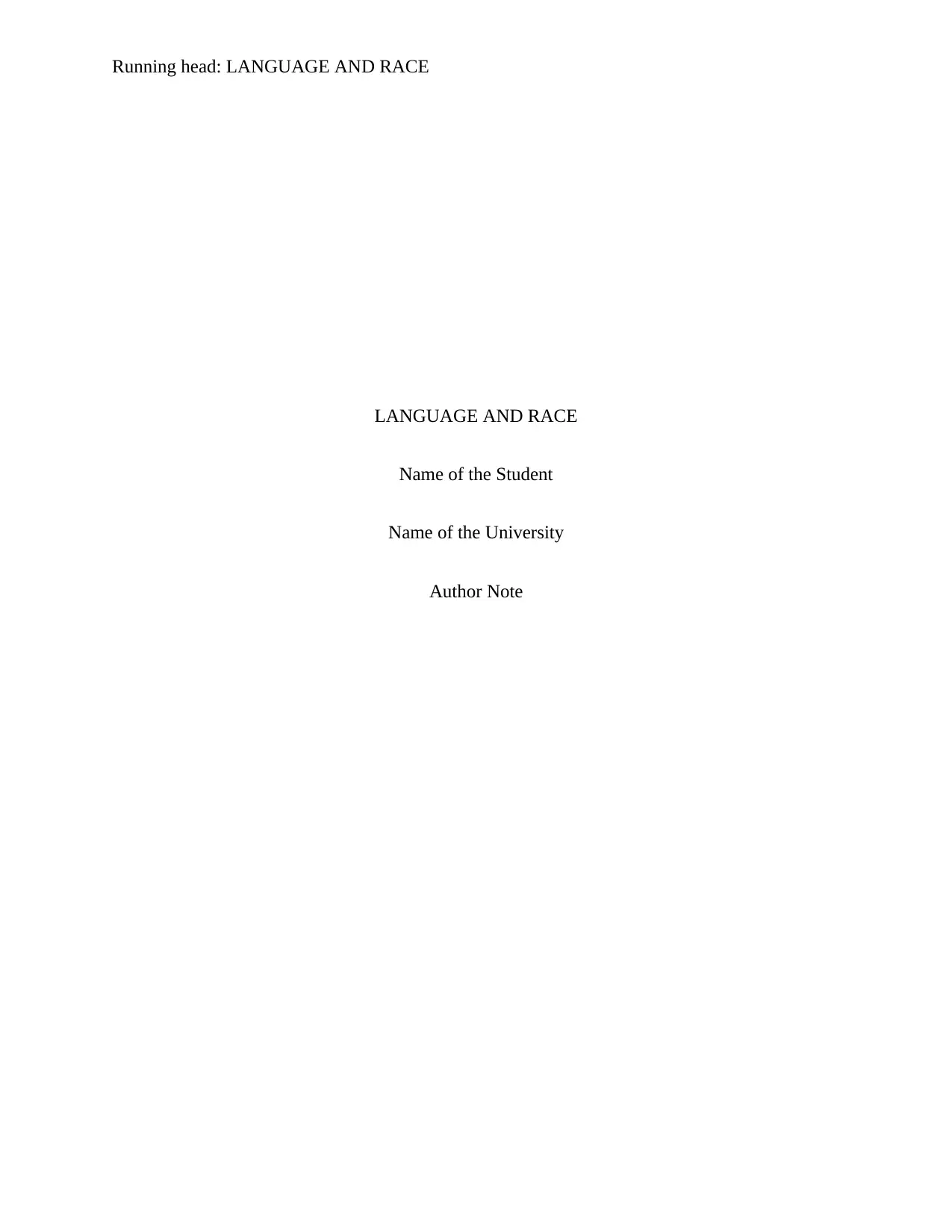
Running head: LANGUAGE AND RACE
LANGUAGE AND RACE
Name of the Student
Name of the University
Author Note
LANGUAGE AND RACE
Name of the Student
Name of the University
Author Note
Secure Best Marks with AI Grader
Need help grading? Try our AI Grader for instant feedback on your assignments.
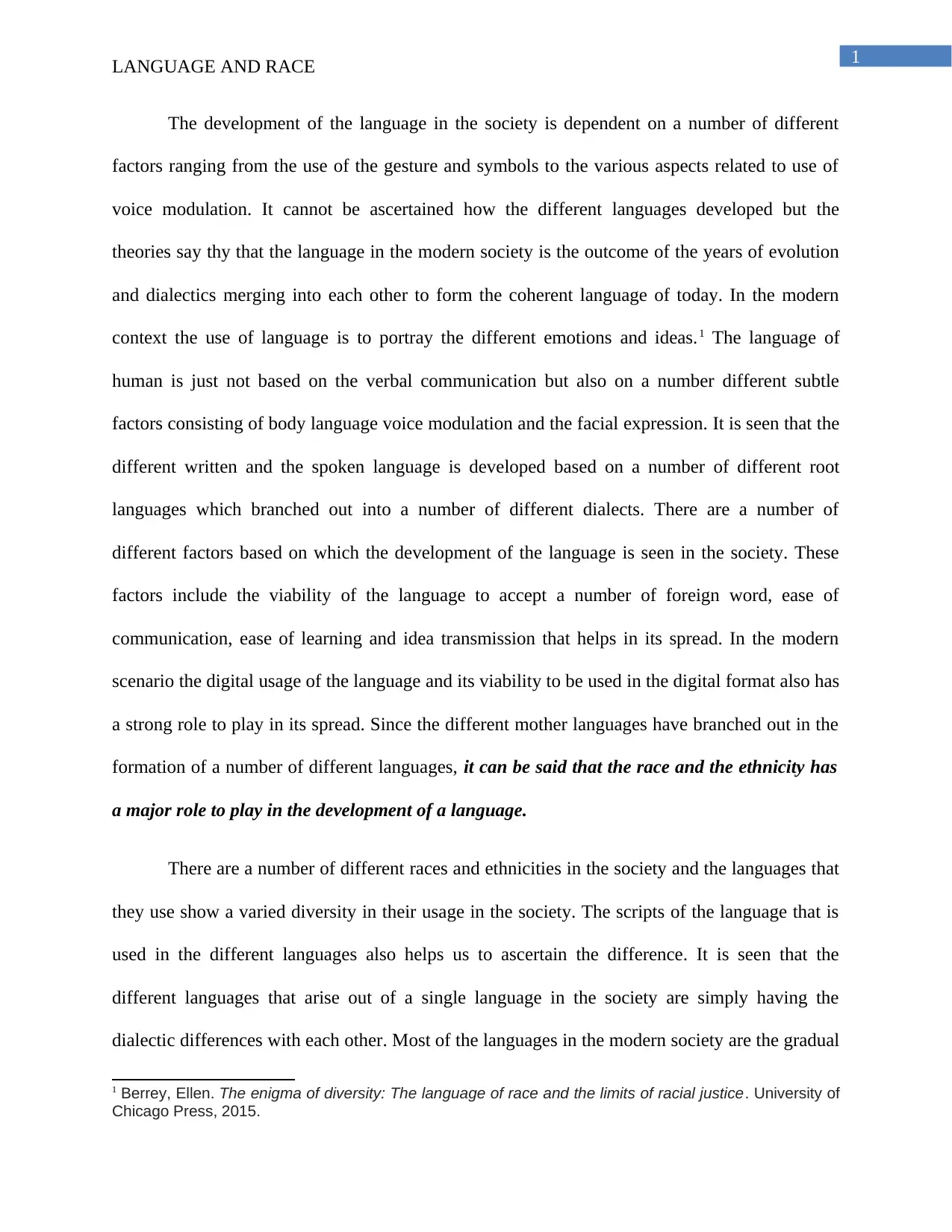
1
LANGUAGE AND RACE
The development of the language in the society is dependent on a number of different
factors ranging from the use of the gesture and symbols to the various aspects related to use of
voice modulation. It cannot be ascertained how the different languages developed but the
theories say thy that the language in the modern society is the outcome of the years of evolution
and dialectics merging into each other to form the coherent language of today. In the modern
context the use of language is to portray the different emotions and ideas.1 The language of
human is just not based on the verbal communication but also on a number different subtle
factors consisting of body language voice modulation and the facial expression. It is seen that the
different written and the spoken language is developed based on a number of different root
languages which branched out into a number of different dialects. There are a number of
different factors based on which the development of the language is seen in the society. These
factors include the viability of the language to accept a number of foreign word, ease of
communication, ease of learning and idea transmission that helps in its spread. In the modern
scenario the digital usage of the language and its viability to be used in the digital format also has
a strong role to play in its spread. Since the different mother languages have branched out in the
formation of a number of different languages, it can be said that the race and the ethnicity has
a major role to play in the development of a language.
There are a number of different races and ethnicities in the society and the languages that
they use show a varied diversity in their usage in the society. The scripts of the language that is
used in the different languages also helps us to ascertain the difference. It is seen that the
different languages that arise out of a single language in the society are simply having the
dialectic differences with each other. Most of the languages in the modern society are the gradual
1 Berrey, Ellen. The enigma of diversity: The language of race and the limits of racial justice. University of
Chicago Press, 2015.
LANGUAGE AND RACE
The development of the language in the society is dependent on a number of different
factors ranging from the use of the gesture and symbols to the various aspects related to use of
voice modulation. It cannot be ascertained how the different languages developed but the
theories say thy that the language in the modern society is the outcome of the years of evolution
and dialectics merging into each other to form the coherent language of today. In the modern
context the use of language is to portray the different emotions and ideas.1 The language of
human is just not based on the verbal communication but also on a number different subtle
factors consisting of body language voice modulation and the facial expression. It is seen that the
different written and the spoken language is developed based on a number of different root
languages which branched out into a number of different dialects. There are a number of
different factors based on which the development of the language is seen in the society. These
factors include the viability of the language to accept a number of foreign word, ease of
communication, ease of learning and idea transmission that helps in its spread. In the modern
scenario the digital usage of the language and its viability to be used in the digital format also has
a strong role to play in its spread. Since the different mother languages have branched out in the
formation of a number of different languages, it can be said that the race and the ethnicity has
a major role to play in the development of a language.
There are a number of different races and ethnicities in the society and the languages that
they use show a varied diversity in their usage in the society. The scripts of the language that is
used in the different languages also helps us to ascertain the difference. It is seen that the
different languages that arise out of a single language in the society are simply having the
dialectic differences with each other. Most of the languages in the modern society are the gradual
1 Berrey, Ellen. The enigma of diversity: The language of race and the limits of racial justice. University of
Chicago Press, 2015.
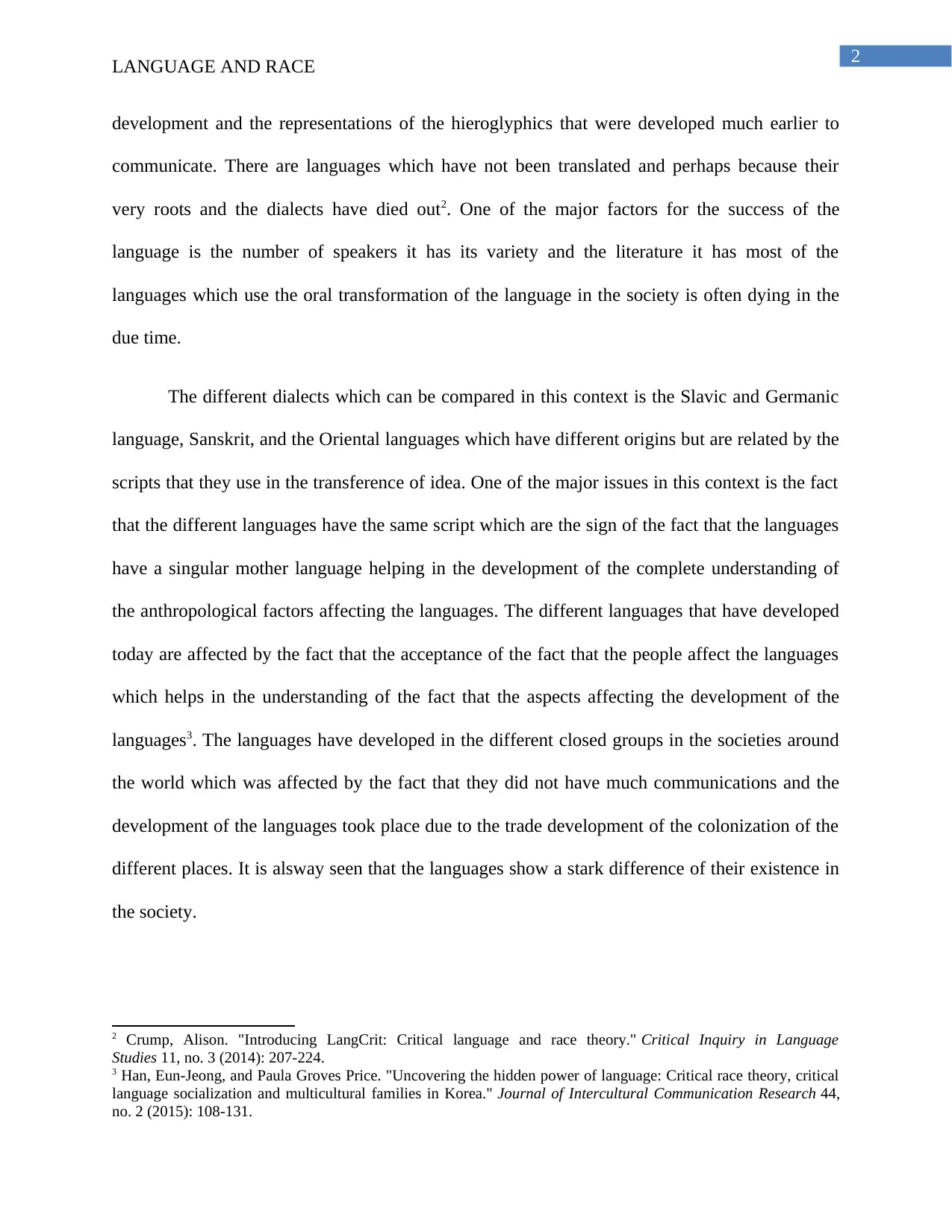
2
LANGUAGE AND RACE
development and the representations of the hieroglyphics that were developed much earlier to
communicate. There are languages which have not been translated and perhaps because their
very roots and the dialects have died out2. One of the major factors for the success of the
language is the number of speakers it has its variety and the literature it has most of the
languages which use the oral transformation of the language in the society is often dying in the
due time.
The different dialects which can be compared in this context is the Slavic and Germanic
language, Sanskrit, and the Oriental languages which have different origins but are related by the
scripts that they use in the transference of idea. One of the major issues in this context is the fact
that the different languages have the same script which are the sign of the fact that the languages
have a singular mother language helping in the development of the complete understanding of
the anthropological factors affecting the languages. The different languages that have developed
today are affected by the fact that the acceptance of the fact that the people affect the languages
which helps in the understanding of the fact that the aspects affecting the development of the
languages3. The languages have developed in the different closed groups in the societies around
the world which was affected by the fact that they did not have much communications and the
development of the languages took place due to the trade development of the colonization of the
different places. It is alsway seen that the languages show a stark difference of their existence in
the society.
2 Crump, Alison. "Introducing LangCrit: Critical language and race theory." Critical Inquiry in Language
Studies 11, no. 3 (2014): 207-224.
3 Han, Eun-Jeong, and Paula Groves Price. "Uncovering the hidden power of language: Critical race theory, critical
language socialization and multicultural families in Korea." Journal of Intercultural Communication Research 44,
no. 2 (2015): 108-131.
LANGUAGE AND RACE
development and the representations of the hieroglyphics that were developed much earlier to
communicate. There are languages which have not been translated and perhaps because their
very roots and the dialects have died out2. One of the major factors for the success of the
language is the number of speakers it has its variety and the literature it has most of the
languages which use the oral transformation of the language in the society is often dying in the
due time.
The different dialects which can be compared in this context is the Slavic and Germanic
language, Sanskrit, and the Oriental languages which have different origins but are related by the
scripts that they use in the transference of idea. One of the major issues in this context is the fact
that the different languages have the same script which are the sign of the fact that the languages
have a singular mother language helping in the development of the complete understanding of
the anthropological factors affecting the languages. The different languages that have developed
today are affected by the fact that the acceptance of the fact that the people affect the languages
which helps in the understanding of the fact that the aspects affecting the development of the
languages3. The languages have developed in the different closed groups in the societies around
the world which was affected by the fact that they did not have much communications and the
development of the languages took place due to the trade development of the colonization of the
different places. It is alsway seen that the languages show a stark difference of their existence in
the society.
2 Crump, Alison. "Introducing LangCrit: Critical language and race theory." Critical Inquiry in Language
Studies 11, no. 3 (2014): 207-224.
3 Han, Eun-Jeong, and Paula Groves Price. "Uncovering the hidden power of language: Critical race theory, critical
language socialization and multicultural families in Korea." Journal of Intercultural Communication Research 44,
no. 2 (2015): 108-131.
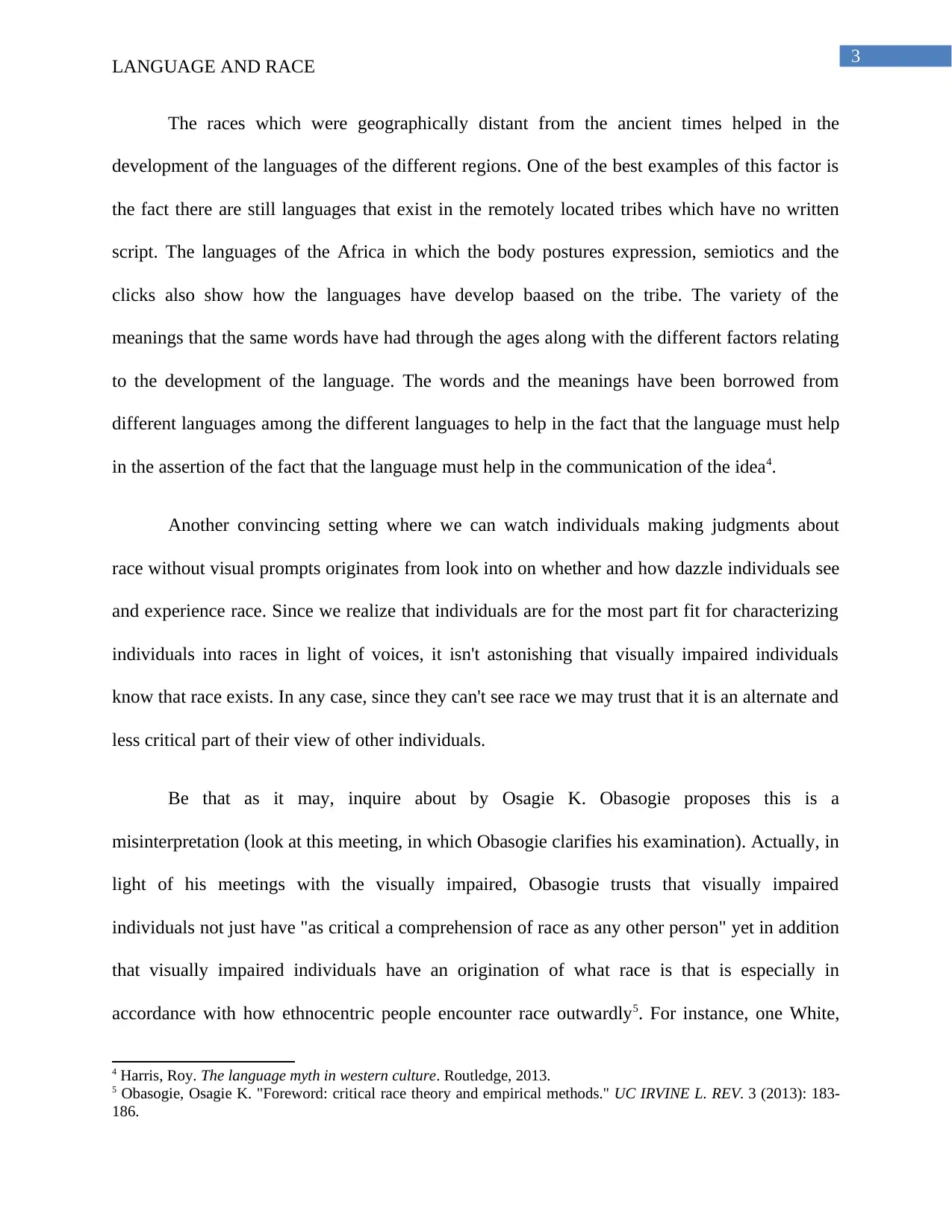
3
LANGUAGE AND RACE
The races which were geographically distant from the ancient times helped in the
development of the languages of the different regions. One of the best examples of this factor is
the fact there are still languages that exist in the remotely located tribes which have no written
script. The languages of the Africa in which the body postures expression, semiotics and the
clicks also show how the languages have develop baased on the tribe. The variety of the
meanings that the same words have had through the ages along with the different factors relating
to the development of the language. The words and the meanings have been borrowed from
different languages among the different languages to help in the fact that the language must help
in the assertion of the fact that the language must help in the communication of the idea4.
Another convincing setting where we can watch individuals making judgments about
race without visual prompts originates from look into on whether and how dazzle individuals see
and experience race. Since we realize that individuals are for the most part fit for characterizing
individuals into races in light of voices, it isn't astonishing that visually impaired individuals
know that race exists. In any case, since they can't see race we may trust that it is an alternate and
less critical part of their view of other individuals.
Be that as it may, inquire about by Osagie K. Obasogie proposes this is a
misinterpretation (look at this meeting, in which Obasogie clarifies his examination). Actually, in
light of his meetings with the visually impaired, Obasogie trusts that visually impaired
individuals not just have "as critical a comprehension of race as any other person" yet in addition
that visually impaired individuals have an origination of what race is that is especially in
accordance with how ethnocentric people encounter race outwardly5. For instance, one White,
4 Harris, Roy. The language myth in western culture. Routledge, 2013.
5 Obasogie, Osagie K. "Foreword: critical race theory and empirical methods." UC IRVINE L. REV. 3 (2013): 183-
186.
LANGUAGE AND RACE
The races which were geographically distant from the ancient times helped in the
development of the languages of the different regions. One of the best examples of this factor is
the fact there are still languages that exist in the remotely located tribes which have no written
script. The languages of the Africa in which the body postures expression, semiotics and the
clicks also show how the languages have develop baased on the tribe. The variety of the
meanings that the same words have had through the ages along with the different factors relating
to the development of the language. The words and the meanings have been borrowed from
different languages among the different languages to help in the fact that the language must help
in the assertion of the fact that the language must help in the communication of the idea4.
Another convincing setting where we can watch individuals making judgments about
race without visual prompts originates from look into on whether and how dazzle individuals see
and experience race. Since we realize that individuals are for the most part fit for characterizing
individuals into races in light of voices, it isn't astonishing that visually impaired individuals
know that race exists. In any case, since they can't see race we may trust that it is an alternate and
less critical part of their view of other individuals.
Be that as it may, inquire about by Osagie K. Obasogie proposes this is a
misinterpretation (look at this meeting, in which Obasogie clarifies his examination). Actually, in
light of his meetings with the visually impaired, Obasogie trusts that visually impaired
individuals not just have "as critical a comprehension of race as any other person" yet in addition
that visually impaired individuals have an origination of what race is that is especially in
accordance with how ethnocentric people encounter race outwardly5. For instance, one White,
4 Harris, Roy. The language myth in western culture. Routledge, 2013.
5 Obasogie, Osagie K. "Foreword: critical race theory and empirical methods." UC IRVINE L. REV. 3 (2013): 183-
186.
Secure Best Marks with AI Grader
Need help grading? Try our AI Grader for instant feedback on your assignments.
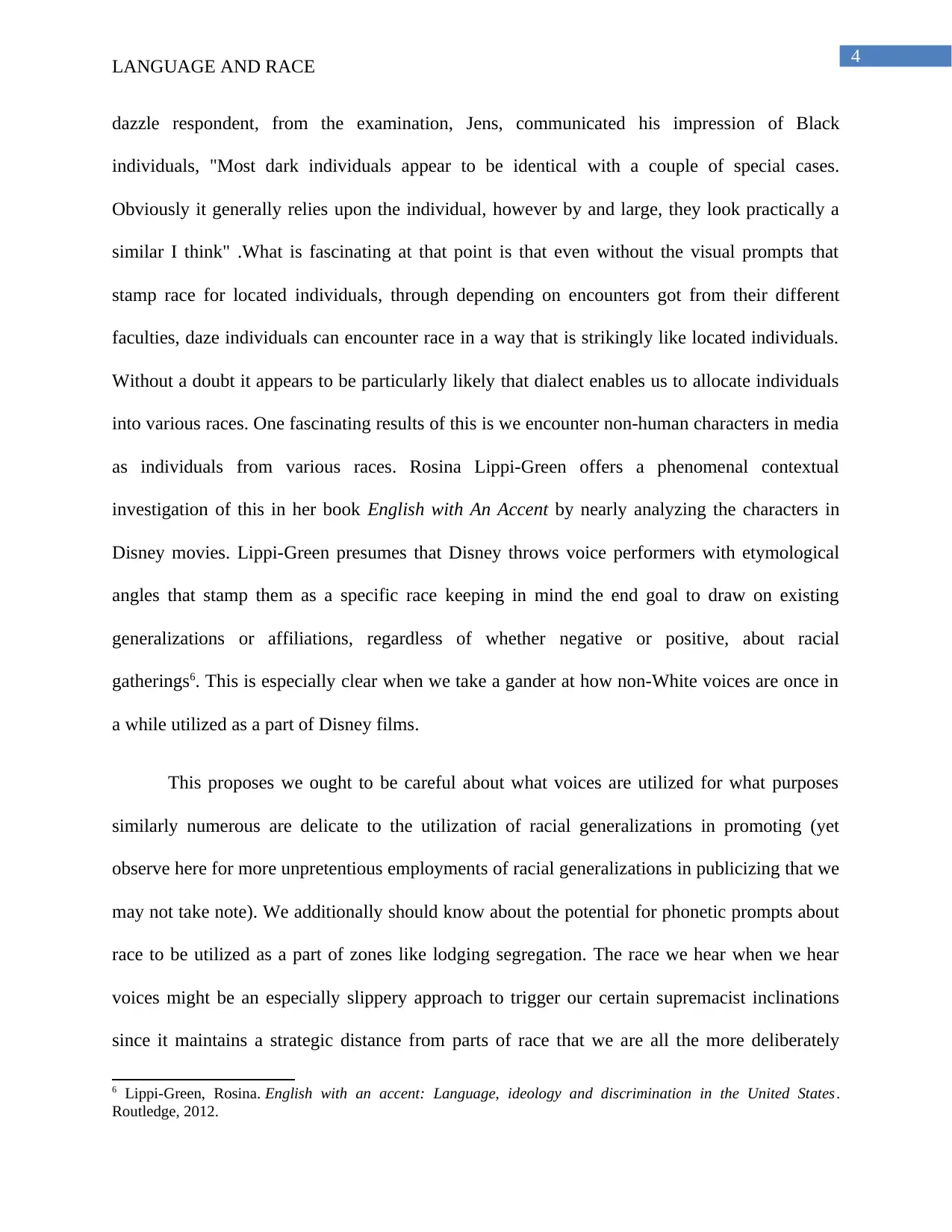
4
LANGUAGE AND RACE
dazzle respondent, from the examination, Jens, communicated his impression of Black
individuals, "Most dark individuals appear to be identical with a couple of special cases.
Obviously it generally relies upon the individual, however by and large, they look practically a
similar I think" .What is fascinating at that point is that even without the visual prompts that
stamp race for located individuals, through depending on encounters got from their different
faculties, daze individuals can encounter race in a way that is strikingly like located individuals.
Without a doubt it appears to be particularly likely that dialect enables us to allocate individuals
into various races. One fascinating results of this is we encounter non-human characters in media
as individuals from various races. Rosina Lippi-Green offers a phenomenal contextual
investigation of this in her book English with An Accent by nearly analyzing the characters in
Disney movies. Lippi-Green presumes that Disney throws voice performers with etymological
angles that stamp them as a specific race keeping in mind the end goal to draw on existing
generalizations or affiliations, regardless of whether negative or positive, about racial
gatherings6. This is especially clear when we take a gander at how non-White voices are once in
a while utilized as a part of Disney films.
This proposes we ought to be careful about what voices are utilized for what purposes
similarly numerous are delicate to the utilization of racial generalizations in promoting (yet
observe here for more unpretentious employments of racial generalizations in publicizing that we
may not take note). We additionally should know about the potential for phonetic prompts about
race to be utilized as a part of zones like lodging segregation. The race we hear when we hear
voices might be an especially slippery approach to trigger our certain supremacist inclinations
since it maintains a strategic distance from parts of race that we are all the more deliberately
6 Lippi-Green, Rosina. English with an accent: Language, ideology and discrimination in the United States.
Routledge, 2012.
LANGUAGE AND RACE
dazzle respondent, from the examination, Jens, communicated his impression of Black
individuals, "Most dark individuals appear to be identical with a couple of special cases.
Obviously it generally relies upon the individual, however by and large, they look practically a
similar I think" .What is fascinating at that point is that even without the visual prompts that
stamp race for located individuals, through depending on encounters got from their different
faculties, daze individuals can encounter race in a way that is strikingly like located individuals.
Without a doubt it appears to be particularly likely that dialect enables us to allocate individuals
into various races. One fascinating results of this is we encounter non-human characters in media
as individuals from various races. Rosina Lippi-Green offers a phenomenal contextual
investigation of this in her book English with An Accent by nearly analyzing the characters in
Disney movies. Lippi-Green presumes that Disney throws voice performers with etymological
angles that stamp them as a specific race keeping in mind the end goal to draw on existing
generalizations or affiliations, regardless of whether negative or positive, about racial
gatherings6. This is especially clear when we take a gander at how non-White voices are once in
a while utilized as a part of Disney films.
This proposes we ought to be careful about what voices are utilized for what purposes
similarly numerous are delicate to the utilization of racial generalizations in promoting (yet
observe here for more unpretentious employments of racial generalizations in publicizing that we
may not take note). We additionally should know about the potential for phonetic prompts about
race to be utilized as a part of zones like lodging segregation. The race we hear when we hear
voices might be an especially slippery approach to trigger our certain supremacist inclinations
since it maintains a strategic distance from parts of race that we are all the more deliberately
6 Lippi-Green, Rosina. English with an accent: Language, ideology and discrimination in the United States.
Routledge, 2012.
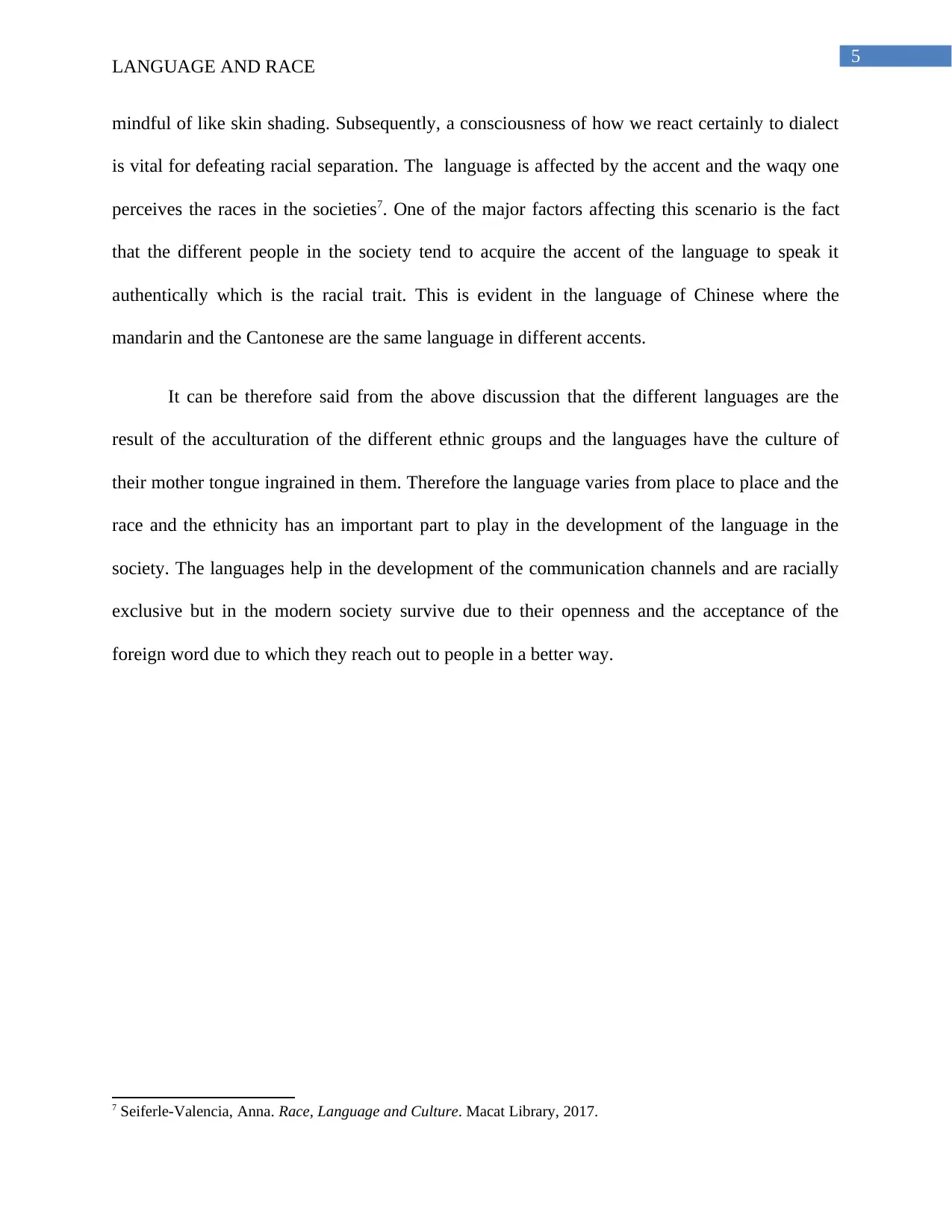
5
LANGUAGE AND RACE
mindful of like skin shading. Subsequently, a consciousness of how we react certainly to dialect
is vital for defeating racial separation. The language is affected by the accent and the waqy one
perceives the races in the societies7. One of the major factors affecting this scenario is the fact
that the different people in the society tend to acquire the accent of the language to speak it
authentically which is the racial trait. This is evident in the language of Chinese where the
mandarin and the Cantonese are the same language in different accents.
It can be therefore said from the above discussion that the different languages are the
result of the acculturation of the different ethnic groups and the languages have the culture of
their mother tongue ingrained in them. Therefore the language varies from place to place and the
race and the ethnicity has an important part to play in the development of the language in the
society. The languages help in the development of the communication channels and are racially
exclusive but in the modern society survive due to their openness and the acceptance of the
foreign word due to which they reach out to people in a better way.
7 Seiferle-Valencia, Anna. Race, Language and Culture. Macat Library, 2017.
LANGUAGE AND RACE
mindful of like skin shading. Subsequently, a consciousness of how we react certainly to dialect
is vital for defeating racial separation. The language is affected by the accent and the waqy one
perceives the races in the societies7. One of the major factors affecting this scenario is the fact
that the different people in the society tend to acquire the accent of the language to speak it
authentically which is the racial trait. This is evident in the language of Chinese where the
mandarin and the Cantonese are the same language in different accents.
It can be therefore said from the above discussion that the different languages are the
result of the acculturation of the different ethnic groups and the languages have the culture of
their mother tongue ingrained in them. Therefore the language varies from place to place and the
race and the ethnicity has an important part to play in the development of the language in the
society. The languages help in the development of the communication channels and are racially
exclusive but in the modern society survive due to their openness and the acceptance of the
foreign word due to which they reach out to people in a better way.
7 Seiferle-Valencia, Anna. Race, Language and Culture. Macat Library, 2017.
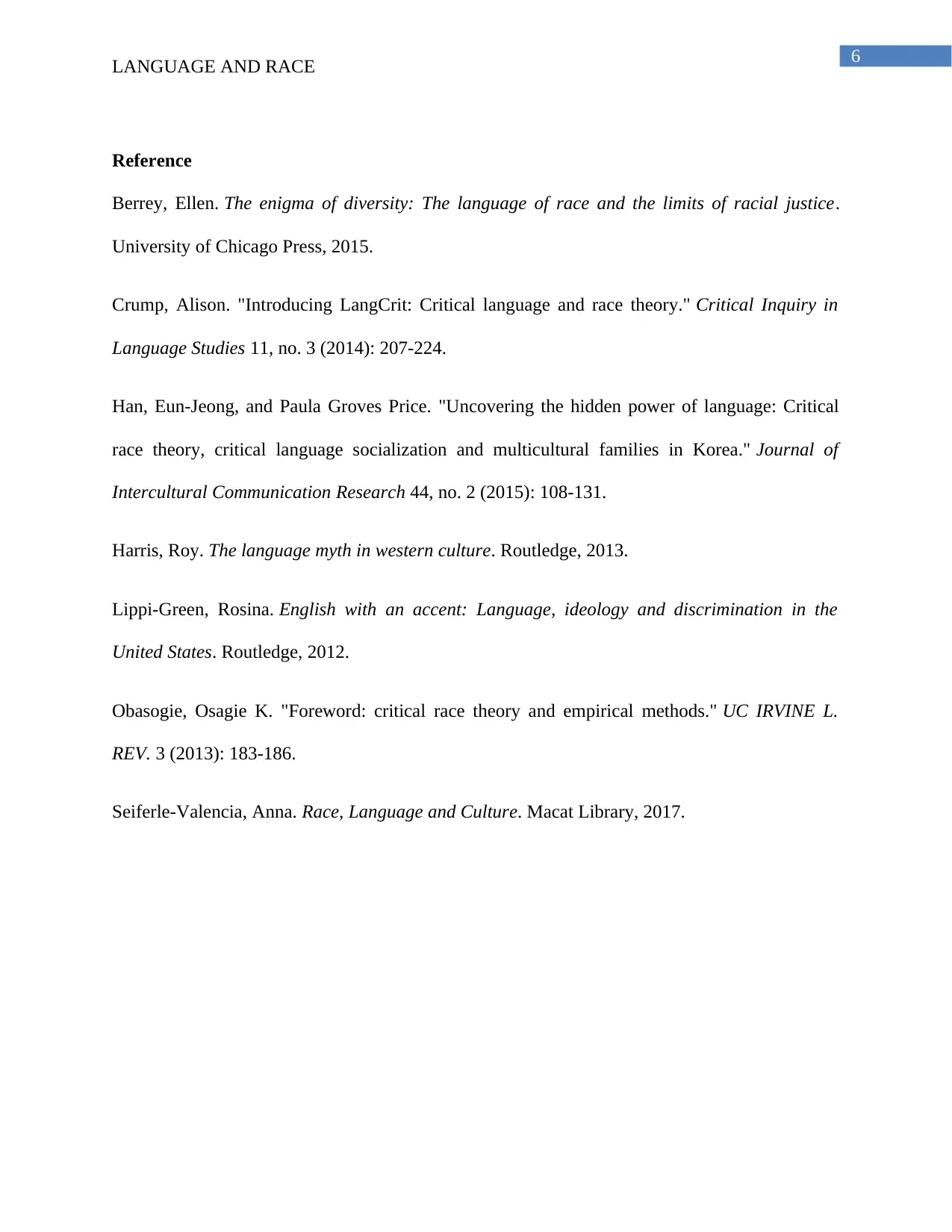
6
LANGUAGE AND RACE
Reference
Berrey, Ellen. The enigma of diversity: The language of race and the limits of racial justice.
University of Chicago Press, 2015.
Crump, Alison. "Introducing LangCrit: Critical language and race theory." Critical Inquiry in
Language Studies 11, no. 3 (2014): 207-224.
Han, Eun-Jeong, and Paula Groves Price. "Uncovering the hidden power of language: Critical
race theory, critical language socialization and multicultural families in Korea." Journal of
Intercultural Communication Research 44, no. 2 (2015): 108-131.
Harris, Roy. The language myth in western culture. Routledge, 2013.
Lippi-Green, Rosina. English with an accent: Language, ideology and discrimination in the
United States. Routledge, 2012.
Obasogie, Osagie K. "Foreword: critical race theory and empirical methods." UC IRVINE L.
REV. 3 (2013): 183-186.
Seiferle-Valencia, Anna. Race, Language and Culture. Macat Library, 2017.
LANGUAGE AND RACE
Reference
Berrey, Ellen. The enigma of diversity: The language of race and the limits of racial justice.
University of Chicago Press, 2015.
Crump, Alison. "Introducing LangCrit: Critical language and race theory." Critical Inquiry in
Language Studies 11, no. 3 (2014): 207-224.
Han, Eun-Jeong, and Paula Groves Price. "Uncovering the hidden power of language: Critical
race theory, critical language socialization and multicultural families in Korea." Journal of
Intercultural Communication Research 44, no. 2 (2015): 108-131.
Harris, Roy. The language myth in western culture. Routledge, 2013.
Lippi-Green, Rosina. English with an accent: Language, ideology and discrimination in the
United States. Routledge, 2012.
Obasogie, Osagie K. "Foreword: critical race theory and empirical methods." UC IRVINE L.
REV. 3 (2013): 183-186.
Seiferle-Valencia, Anna. Race, Language and Culture. Macat Library, 2017.
1 out of 7
Your All-in-One AI-Powered Toolkit for Academic Success.
+13062052269
info@desklib.com
Available 24*7 on WhatsApp / Email
![[object Object]](/_next/static/media/star-bottom.7253800d.svg)
Unlock your academic potential
© 2024 | Zucol Services PVT LTD | All rights reserved.